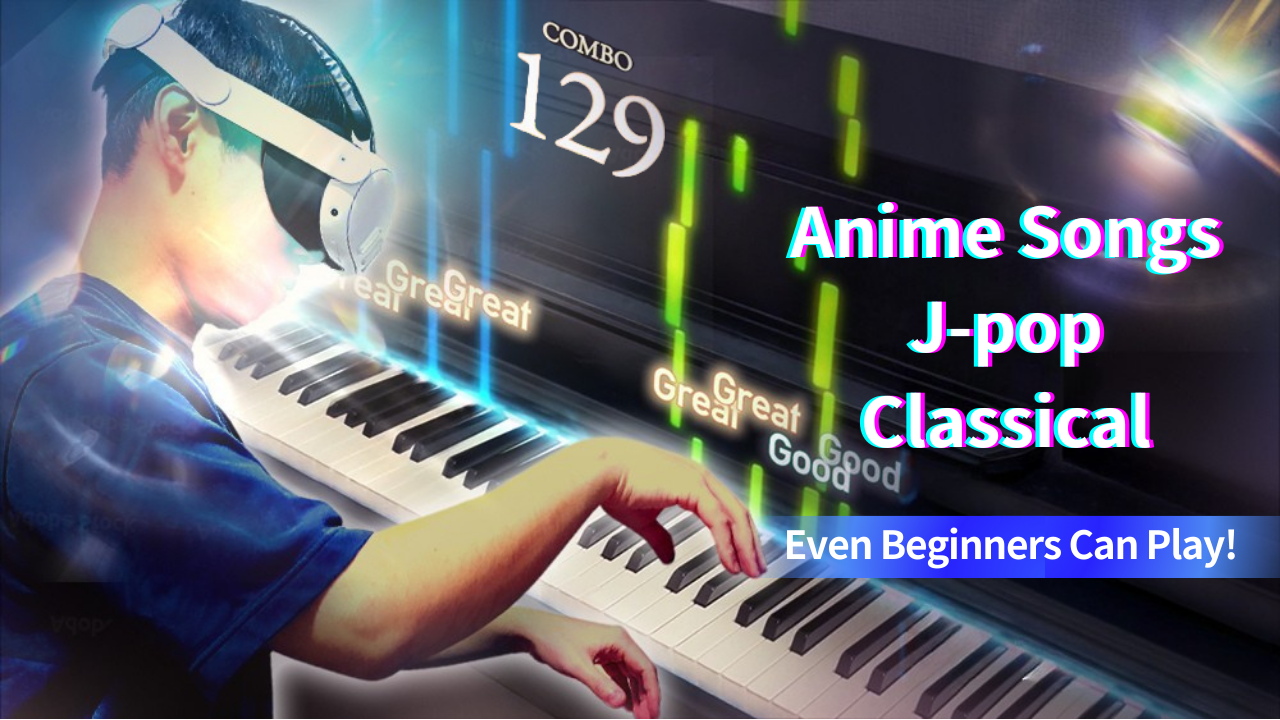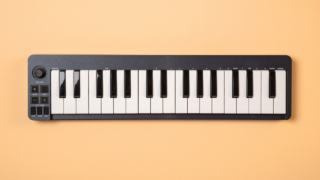When reading piano sheet music, it’s important to understand the meanings of various musical symbols.
Once you grasp these correctly, you can broaden your range of expression, elevating your performance level.
In this article, we have compiled a list of the musical symbols needed to read sheet music and explained their meanings and usage in an easy-to-understand way using diagrams and videos.
- Basic Structure of Piano Sheet Music
- Clefs and Accidentals
- Notes, Time Signatures, Dotted Notes, and Tuplets
- Octave Markings
- Basic Knowledge of Key Signatures and Transposition
- Tempo Markings (Speed Indications)
- Ornamentation Symbols
- Articulation Marks
- Repeat Signs & Performance Instructions
- Swing
- Grace Notes
- Right Hand and Left Hand (R.H. / L.H.)
- Dynamic Markings
- Expression Markings
- Pedal Markings
- Other Common Abbreviations and Symbols
- Conclusion
Basic Structure of Piano Sheet Music
Five-line Staff

The “five-line staff” with five horizontal lines forms the basic foundation of standard music notation.
It indicates pitch and rhythm, and for piano music, it is common to use two staves: upper and lower.
Upper Staff / Lower Staff
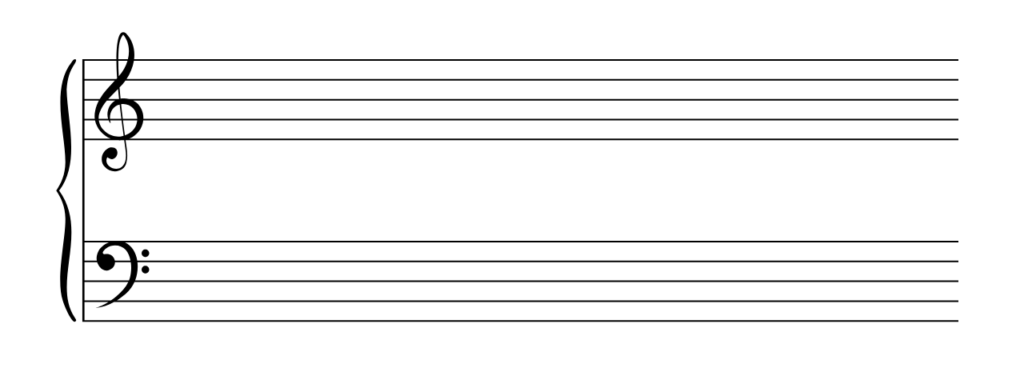
- Upper Staff: Primarily for the higher register played with the right hand
- Lower Staff: Primarily for the lower register played with the left hand
Bar Line

- A segment of music divided by a bar line is called a measure. The vertical line that marks the boundary of the measure is called the bar line.
- Double Bar Line: Two adjacent bar lines indicating a boundary, such as the end of a section or part of the piece
- Final Bar Line: Two lines of different thicknesses used to mark the end of a piece or the last measure of a movement
Clefs and Accidentals
-1024x438.png)
Clefs (Treble Clef, Bass Clef)
Treble Clef (![]() ): Often used for the higher register, typically played with the right hand.
): Often used for the higher register, typically played with the right hand.
Bass Clef (![]() ): Often used for the lower register, typically played with the left hand.
): Often used for the lower register, typically played with the left hand.
Accidentals

- Sharp (♯): Raises the note by a semitone.
- Flat (♭): Lowers the note by a semitone.
- Natural (♮): Returns the note to its original pitch.
- Double Sharp (
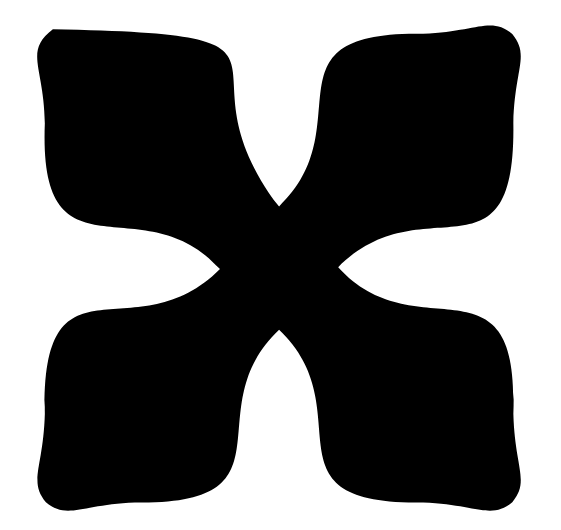 ): Raises the note by a whole tone.
): Raises the note by a whole tone. - Double Flat (♭♭): Lowers the note by a whole tone.
Accidentals are valid only within the measure in which they appear. Once you cross the bar line, their effect no longer applies, so be mindful of that.
Notes, Time Signatures, Dotted Notes, and Tuplets
Notes

Whole Note: 4 beats
Half Note: 2 beats
Quarter Note: 1 beat
Eighth Note: 1/2 beat
Sixteenth Note: 1/4 beat
Rests

Whole Rest: Rest for 4 beats
Half Rest: Rest for 2 beats
Quarter Rest: Rest for 1 beat
Eighth Rest: Rest for 1/2 beat
Sixteenth Rest: Rest for 1/4 beat
Time Signatures

- 4/4 Time: 4 beats per measure (sometimes indicated by the “C” symbol)
- 3/4 Time: Commonly used in waltzes
- 2/4 Time: Commonly used in marches
- 6/8 Time: One measure contains six eighth notes
Dotted Notes

A dotted note adds half of its original value.
Example: Quarter note (1 beat) + half of that (0.5 beats) = 1.5 beats
Tuplets

Triplets, quintuplets, septuplets, etc. are used to fit more notes than usual in one measure or beat, with each note played evenly.
Octave Markings
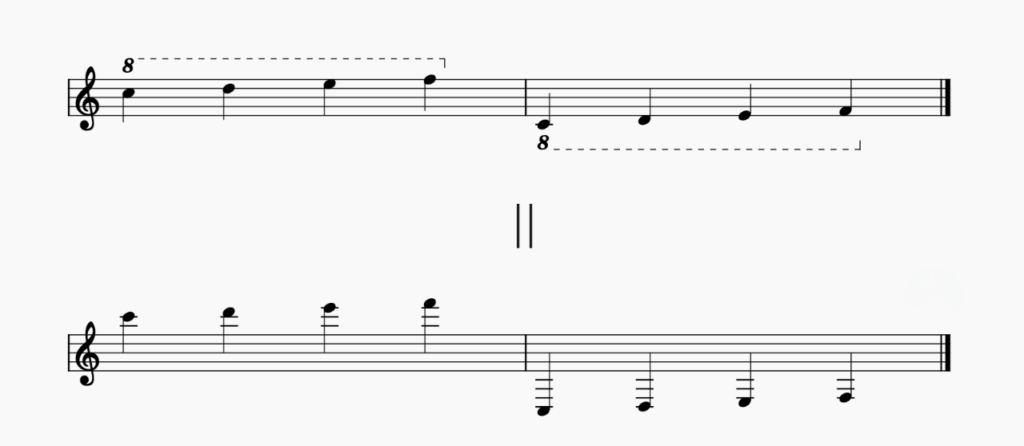
8va (Ottava): Play one octave higher
8vb (Ottava Bassa): Play one octave lower
Basic Knowledge of Key Signatures and Transposition

Key Signatures
Sharps or flats written at the beginning of the staff.
- 1 Sharp: G Major (G major), E Minor (E minor)
- 1 Flat: F Major (F major), D Minor (D minor)
Reference Article
Transposition
Changing the key of a piece to a different pitch. This is done for choruses, accompaniments to match a vocalist’s range, or to alter the musical effect.
On the piano, the use of black and white keys changes accordingly to the new key signature.
Tempo Markings (Speed Indications)
They are mostly written in Italian, and are often accompanied by a BPM (beats per minute) guideline.
| Tempo | Meaning | Approx. BPM |
|---|---|---|
| Largo | Very broad and slow | 40–60 |
| Adagio | Slow | 66–76 |
| Andante | Walking pace | 76–108 |
| Moderato | Moderate speed | 108–120 |
| Allegro | Lively and fast | 120–168 |
| Presto | Very fast | 168–200 or so |
*Interpretation may vary depending on the piece.
Ornamentation Symbols
Arpeggio (arpeggio)
Instead of playing a chord all at once, you play each note one by one.
Trill (trill)
Example: Alternate quickly between the main note and the note above it.
Tremolo (tremolo)
Rapidly alternate or repeat the same note or two different notes.
Glissando (glissando)
Slide from one note to another continuously. On piano, this is done by sliding a finger across the keys.
Articulation Marks
These are performance indications that describe how notes should be connected, separated, or emphasized.
Staccato
Notated as “・” : Play the note short and detached.
Staccatissimo
![]() : Even shorter and more emphasized than staccato.
: Even shorter and more emphasized than staccato.
Tenuto
“−”: Sustain the note fully.
Tenuto Staccato
![]() : Similar to staccato but with a sense of sustaining rather than cutting off the note abruptly.
: Similar to staccato but with a sense of sustaining rather than cutting off the note abruptly.
Accent
“>”: Place emphasis on that note.
Marcato
![]() : Play each note distinctly and with emphasis.
: Play each note distinctly and with emphasis.
Accent Staccato
![]() : Play short but with emphasis.
: Play short but with emphasis.
Marcato Staccato
![]() : Play short and clearly emphasize each note.
: Play short and clearly emphasize each note.
Fermata (fermata)
Hold the note or rest longer than its usual duration.
Slur

Play multiple notes smoothly and connected.
Tie
A curved line that connects notes of the same pitch, adding their durations together.
- Slur: An articulation marking indicating to play notes smoothly and connected
- Tie: A symbol that connects notes of the same pitch, adding their durations together
Repeat Signs & Performance Instructions
These symbols indicate the structure of the piece.
Repeat Sign
Indicated by “:||” on the bar line. Repeat the portion between the matching repeat signs.
First and Second Ending
Use the brackets (1st ending, 2nd ending) to determine which measures to repeat and which to skip on the second pass.
D.C. (Da Capo)
Return to the beginning of the piece. “D.C. al Fine” means go back to the start and play until “Fine.”
D.S. (Dal Segno)
Return to the “Segno” mark (![]() ) in the score.
) in the score.
Coda
![]() : The final section of the piece. Often used together with D.C. or D.S. to jump to the ending.
: The final section of the piece. Often used together with D.C. or D.S. to jump to the ending.
Swing
Swing means to play with a “swung” rhythm. To revert to the original straight rhythm, you may see “Straight.”
When playing eighth notes in Swing, the first note is lengthened (about 2/3), and the second note is shortened (about 1/3).
Commonly used in jazz, but sometimes appears in pop or other genres.
Grace Notes
Grace notes are short notes added to the main melody to embellish or decorate, and are not part of the main melodic or rhythmic structure.
They play a supplementary role, adding nuance and flair to the music.
Long Appoggiatura: A longer grace note that “borrows” a bit from the main note’s value.
Short Appoggiatura: Played quickly just before the main note.
Multiple Grace Notes: Two or more short notes quickly played before the main note.
Right Hand and Left Hand (R.H. / L.H.)

R.H. (Right Hand) and L.H. (Left Hand) specify which hand to use.
They are often used when you need to cross your arms.
“R.H.” in the lower staff: Covering part of the lower range typically played by the left hand.
“L.H.” in the higher staff: Covering part of the higher range typically played by the right hand.
m.d. = mano destra (right hand)
m.s. = mano sinistra (left hand)
m.d. = main droite (right hand)
m.g. = main gauche (left hand)
Dynamic Markings

These symbols indicate the volume and intensity of performance.
- pp (pianissimo): Very soft
- p (piano): Soft
- mp (mezzo piano): Moderately soft
- mf (mezzo forte): Moderately loud
- f (forte): Loud
- ff (fortissimo): Very loud
You may also see additional or intermediate markings like sfz (sforzando) or fp (forte piano) to indicate emphasis on a particular note followed by a sudden drop in volume, etc.
Expression Markings

These markings can greatly influence the character and atmosphere of the piece. They are mostly written in Italian, though English, German, or French may appear as well.
- dolce: Gently, sweetly
- cantabile: In a singing style
- agitato: Agitated, intense
- tranquillo: Calmly, tranquilly
- legato: Smooth, connected
- con spirito: With spirit, energetically
Pedal Markings

Ped. indicates where to press the damper pedal (right pedal). A release mark “✱” or a line is often written to show when to release it.
• una corda: Instruction to press the soft pedal (left pedal) to soften the sound.
• tre corde: Instruction to release the soft pedal, returning to the normal sound.
Other Common Abbreviations and Symbols

- rit. (ritardando): Gradually slow down
- rall. (rallentando): Also gradually slow down
- accel. (accelerando): Gradually speed up
- cres. (crescendo): Gradually get louder (sometimes written as “<”)
- dim. (diminuendo) / decresc. (decrescendo): Gradually get softer (sometimes written as “>”)
- poco a poco: Little by little
- molto: Very
- sub. (subito): Suddenly
Conclusion
By understanding this Piano Musical Symbols List, you can more accurately capture the composer’s intentions and express the music with greater depth.
The piano has a wide range and allows for diverse expression using both hands, which is why there are so many symbols.
If you ever wonder, “What does that symbol mean again?” please revisit this article. Whether you are a beginner or revisiting the basics as an experienced player, we hope you find this helpful.

